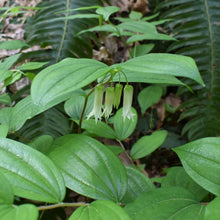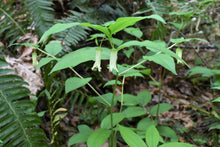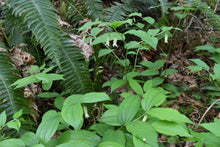Disporum smithii, Prosartes smithii
Fairy Lanterns is a gorgeous shade-loving perennial that is both delicate and strong in a woodland garden. In spring, its bright white flowers generally bloom in clusters of up to seven blooms dangling from the branch tips. The graceful branching pattern of its stems and leathery leaves are quite architectural, and hold their artful form for most of the growing season. By late summer, the flowers mature into shiny orange fruits, a color as noteworthy as it is uncommon in native gardens.
- Plant type/canopy layer: deciduous perennial herbaceous plant
- Size at maturity: 1-3' tall, 1-2' wide
- Light requirements: full shade, part sun / part shade
- Moisture requirements: moist soil
- Bloom Time: April - June
- Growth rate/ease: moderate growth rate, easy to grow
- Wildlife support: attracts bees and other insect pollinators, supports hummingbirds
- Native habitat/range: common in shady damp thickets, montane conifer and mixed-evergreen forests, and exposed roadsides up to 2300 meters across most of western OR, north into British Columbia, south to CA and east to MT and MI. Portland Plant List - yes.
- Special features & uses: attracts and supports hummingbirds
Gardening with Fairy Lanterns: This cheerful wildflower is ideal for moist areas of your shady woodland gardens. Unlike it's cousin, Hooker's Fairybells, this beauty is less-tollerant of drought, so some supplimental water may be needed if planted in drier areas. It requires high organic matter so be sure to integrate compost initially, as needed, and to leave the fall leaves where they fall each year. It’s form stands taller than most groundcovers with a strong, robust look to its stems and leaves, so it works well interplanted in the middle of beds where it can strike a pose above ground covers like native violets, candy flower, and wild ginger.
Photo Credits: Nikkie West, Sparrowhawk Native Plants






